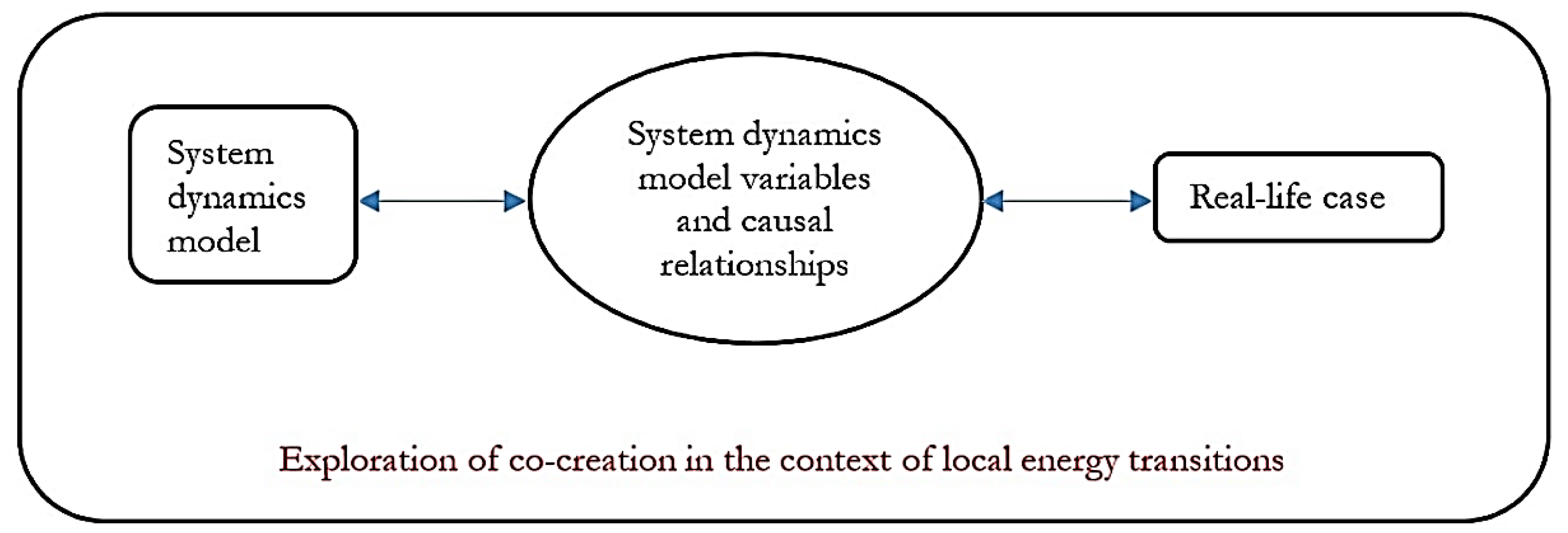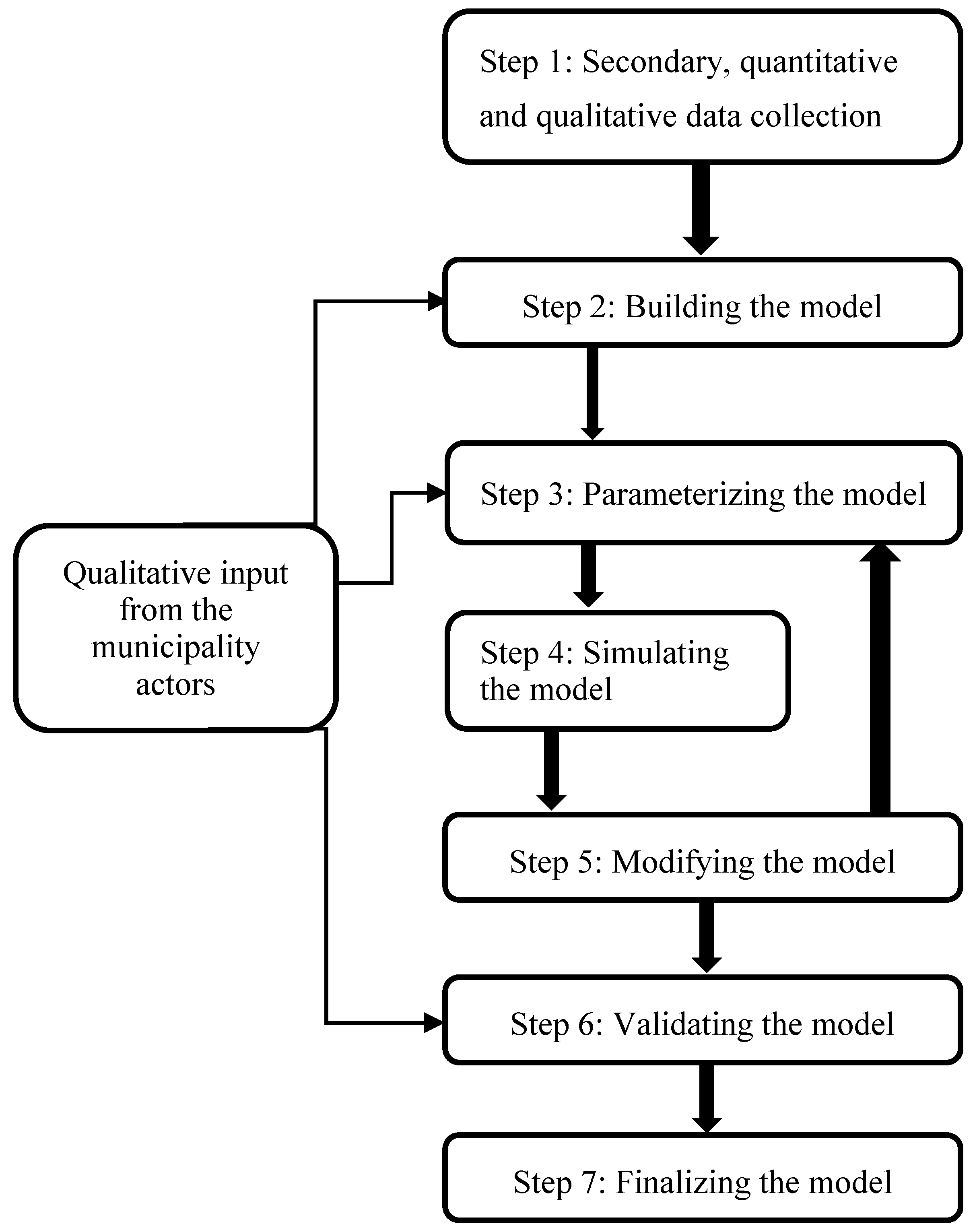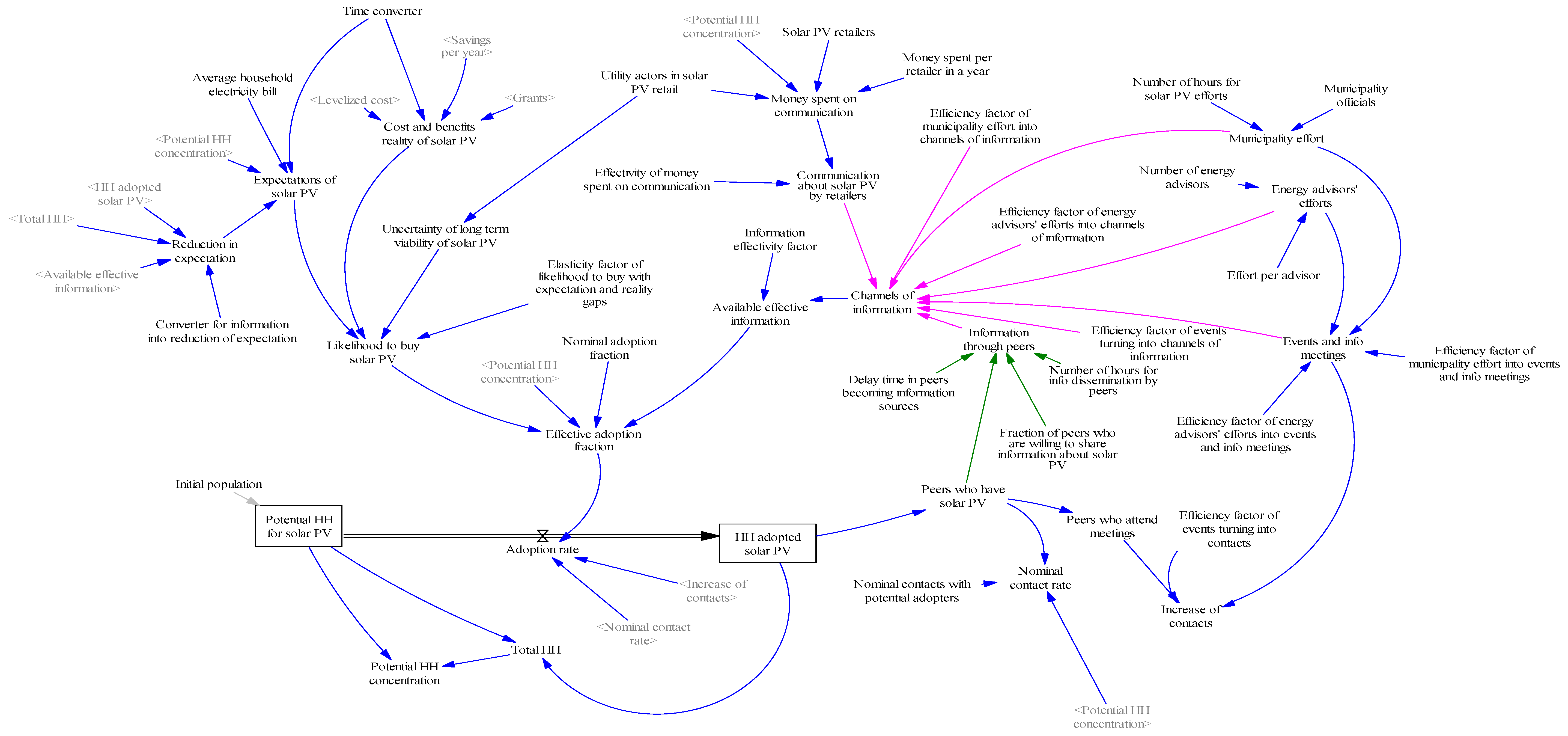Model-Based Exploration of Co-Creation Efforts: The Case of Solar Photovoltaics (PV) in Skåne, Sweden
Abstract
1. Introduction
2. What Is Co-Creation, and How Can It Be Explained in the Context of Local Energy Transitions?
2.1. Co-Creation: Theories and Concepts
- Co-creation’s objective is to give lasting solutions to the parts of society that requires it; a society which has needs and challenges. Thus, it looks beyond technological innovations and then the focus shifts to how co-creation creates value.
- It changes the social relationships between the stakeholders, in that it changes the context in which existing practices used to happen.
- Pursuant to the first point, to create or give solutions that matter and are relevant to the society’s needs, relevant stakeholders are involved in the design, implementation or adoption of an innovation. This corresponds with the concept of open innovation.
- Co-creation is not just the production of solutions/outcomes but also the process of innovation. This is neither institutionalized innovation such as in an R&D in a lab nor limited to the entrepreneurial ability of a single person, but rather groups of stakeholders cooperating, sharing, and exchanging vital resources. However, this open innovation process is an embedded process, which takes place in a specific local and institutional context.
2.2. Co-Creation within the Context of Energy Transitions
3. Methods and Models
3.1. Interaction with the Municipality Actors
3.2. Determining the Causal Relationships
3.3. Model Development
3.3.1. Step 1. Data Collection
Primary Qualitative Methods
Secondary Qualitative Methods
Secondary Quantitative Methods
3.3.2. Steps 2–7: System Dynamics (SD) Modelling
3.4. The Project Background
4. Model Development Process
4.1. Initial Model
4.2. Iteration 1: First Discussion with the Municipality Actors
- Arranging information meetings and events
- Acting to establish study circles, which act as long-term channels of information
- Managing expectations directly, of citizens who inquire about solar PV for their homes
4.3. Iteration 2: Discussion with the MAs
- Inclusion of commercial retailers of solar PV panels in Skåne, and their effect on advertising and communication
- A more robust representation of expected and actual benefits and their linking to the adoption fraction.
4.4. Final Model
5. Discussion and Conclusions
Author Contributions
Funding
Acknowledgments
Conflicts of Interest
Appendix A
| Variable Name | Equations | Unit |
|---|---|---|
| Actual benefits | Savings per year | SEK |
| Adoption rate | Effective adoption fraction × Contact rate | Households/Year |
| Channels of information | (Energy advisors’ efforts × 0.01) + (Events and info meetings × 0.01) + (Municipality effort × 0.25) + Information through peers | Hours/Year |
| Contact rate | (Increase of contacts + Nominal contacts with potential adopters) × HH adopted solar PV × Potential HH concentration | Households/Year |
| Cost savings from solar PV | INTEG (Savings per year, 0) | SEK |
| Effective adoption fraction | Effectiveness of expectation management + Effectiveness of information + Nominal adoption fraction | Dimensionless |
| Effectiveness of expectation management | Converter 0 × (IF THEN ELSE (Expectation gap >= 0, SMOOTH (Expectation gap, Delay time in expectation management), 0)) | Dimensionless |
| Effectiveness of information | SMOOTH (Channels of information, Delay time in information dissemination ) × Converter 1 | Dimensionless |
| Energy advisors’ efforts | Effort per advisor × Number of energy advisors | Hours/Year |
| Events and info meetings | Energy advisors’ efforts × 0.05 + Municipality effort × 0.05 | Hours/Year |
| Expectation gap | Expected benefits-Actual benefits + Expectation management | SEK |
| Expectation management | (Municipality effort × 0.5 × Expectation management converter) + Info to manage expectations | SEK |
| HH adopted solar PV | INTEG (Adoption rate, 5000) | Households |
| Increase of contacts | Event contact converter × Events and info meetings | 1/Year |
| Info to manage expectations | Channels of information × Converter 2 × 0.01 | SEK |
| Information through peers | Number of hours for info dissemination by peers × SMOOTH (Peers who have solar PV, Delay time in peers becoming information sources) | Hours/Year |
| Municipality effort | Municipality officials × Number of hours for solar PV efforts | Hours/Year |
| Municipality officials | 2-STEP (2, 9) | Dimensionless |
| Number of energy advisors | 12-STEP (6, 6 )–STEP(6, 12) | Dimensionless |
| Peers who have solar PV | HH adopted solar PV | Households |
| Potential HH concentration | Potential HH for solar PV/Total HH | Dimensionless |
| Potential HH for solar PV | INTEG (−Adoption rate, Initial population) | Households |
| Savings per year | Savings per unit of electricity × Units of solar PV electricity generated | SEK/Year |
| Total HH | HH adopted solar PV + Potential HH for solar PV | Households |
| Variable Name | Parameters | Unit |
|---|---|---|
| Converter 0 | 0.000001 | 1/SEK |
| Converter 1 | 0.0000001 | Year/Hours |
| Converter 2 | 1 | Year × SEK/Hours |
| Delay time in expectation management | 0.5 | Year |
| Delay time in information dissemination | 0.5 | Year |
| Delay time in peers becoming information sources | 0.75 | Year |
| Effort per advisor | 1200 | Hours/Year |
| Event contact converter | 0.0005 | 1/Hours |
| Expectation management converter | 1 | Year/Hours × SEK |
| Expected benefits | 18,000 | SEK |
| Initial population | 270,000 | Households |
| Nominal adoption fraction | 0.05 | Dimensionless |
| Nominal contacts with potential adopters | 2 | 1/Year |
| Number of hours for info dissemination by peers | 2.5 | Hours/(Year × Households) |
| Number of hours for solar PV efforts | 750 | Hours/Year |
| Variable Name | Equations and Parameters | Unit |
|---|---|---|
| Average household solar PV capacity | 5 | kW |
| Average lifetime of solar PV | 25 | Year |
| Cost of capital | 0.019 | Dimensionless |
| Feed-in-Tariffs | 0.5 | SEK/kWh |
| Grants | Stochastic: (0,0), (25,20,000), (0,20,000), (5,10,000), (10,5000), (20,0), (25,0) | SEK |
| Initial investment cost per capacity | Stochastic: (0,20,000), (25,20,000), (0,19,450), (1,19,450), (5,18,000), (1,16,000), (15,15,000), (20,14,500), (25,14,000) | SEK/kW |
| Investment cost | (Average household solar PV capacity × Initial investment cost per capacity) − Grants | SEK |
| Normalized investment cost per year | (Investment cost × ((1 + Cost of capital)25))/Average lifetime of solar PV | SEK/Year |
| Price of electricity | Stochastic: (0,0), (25,10), (0,1.7), (1,1.7), (5,1.8), (10,2), (15,2.2), (20,2.3), (25,2.4) | SEK/kWh |
| Savings per unit of electricity | Price of electricity − Unit cost of solar electricity + Feed-in-Tariffs + Tax subsidies | SEK/kWh |
| Savings per year | Savings per unit of electricity × Units of solar PV electricity generated | SEK/Year |
| Tax subsidies | 0.6 | SEK/kWh |
| Unit cost of solar electricity | Normalized investment cost per year/Units of solar PV electricity generated | SEK/kWh |
| Units of solar PV electricity generated | 900 | kWh/Year |
References
- OECD. Together for Better Public Services: Partnering with Citizens and Civil Society; OECD: Paris, France, 2011; pp. 25–43. [Google Scholar]
- Bureau of European Policy Advisers(BEPA). Social Innovation—A Decade of Changes; BEPA: Luxembourg, 2014. [Google Scholar]
- Loorbach, D.; Frantzeskaki, N.; Avelino, F. Sustainability Transitions Research: Transforming Science and Practice for Societal Change. Annu. Rev. Environ. Resour. 2017, 42, 599–626. [Google Scholar] [CrossRef]
- Seyfang, G.; Hielscher, S.; Hargreaves, T.; Martiskainen, M.; Smith, A. A grassroots sustainable energy niche? Reflections on community energy in the UK. Environ. Innov. Soc. Transit. 2014, 13, 21–44. [Google Scholar] [CrossRef]
- Van Der Schoor, T.; Van Lente, H.; Scholtens, B.; Peine, A. Challenging obduracy: How local communities transform the energy system. Energy Res. Soc. Sci. 2016, 13, 94–105. [Google Scholar] [CrossRef]
- Süsser, D.; Döring, M.; Ratter, B.M.W. Harvesting energy: Place and local entrepreneurship in community-based renewable energy transition. Energy Policy 2017, 101, 332–341. [Google Scholar] [CrossRef]
- Selvakkumaran, S.; Ahlgren, E.O. Understanding the local energy transitions process: A systematic review. Int. J. Sustain. Energy Plan. Manag. 2017, 14. [Google Scholar] [CrossRef]
- Palm, J.; Thoresson, J. Strategies and Implications for Network Participation in Regional Climate and Energy Planning. J. Environ. Policy Plan. 2013, 16, 3–19. [Google Scholar] [CrossRef]
- Palm, J. Development of sustainable energy systems in Swedish municipalities: A matter of path dependency and power relations. Local Environ. 2006, 11, 445–457. [Google Scholar] [CrossRef]
- Beermann, J.; Tews, K. Decentralised laboratories in the German energy transition. Why local renewable energy initiatives must reinvent themselves. J. Clean. Prod. 2017, 125–134. [Google Scholar] [CrossRef]
- Ruth, M.; Özgün, O.; Wachsmuth, J.; Gößling-Reisemann, S. Dynamics of energy transitions under changing socioeconomic, technological and climate conditions in Northwest Germany. Ecol. Econ. 2015, 111, 29–47. [Google Scholar] [CrossRef]
- Mattes, J.; Huber, A.; Koehrsen, J. Energy transitions in small-scale regions—What we can learn from a regional innovation systems perspective. Energy Policy 2015, 78, 255–264. [Google Scholar] [CrossRef]
- Viétor, B.; Hoppe, T.; Clancy, J. Decentralised combined heat and power in the German Ruhr Valley; assessment of factors blocking uptake and integration. Energy Sustain. Soc. 2015, 5, 5. [Google Scholar] [CrossRef]
- Chilvers, J.; Longhurst, N. Participation in Transition(s): Reconceiving Public Engagements in Energy Transitions as Co-Produced, Emergent and Diverse. J. Environ. Policy Plan. 2016, 18, 585–607. [Google Scholar] [CrossRef]
- Hufen, J.A.M.; Koppenjan, J.F.M. Local renewable energy cooperatives: Revolution in disguise? Energy Sustain. Soc. 2015, 5, 18. [Google Scholar] [CrossRef]
- Geels, F.W.; Schot, J. Typology of sociotechnical transition pathways. Res. Policy 2007, 36, 399–417. [Google Scholar] [CrossRef]
- Geels, F.W.; Kemp, R. Dynamics in socio-technical systems: Typology of change processes and contrasting case studies. Technol. Soc. 2007, 29, 441–455. [Google Scholar] [CrossRef]
- Geels, F.W.; Kern, F.; Fuchs, G.; Hinderer, N.; Kungl, G.; Mylan, J.; Neukirch, M.; Wassermann, S. The enactment of socio-technical transition pathways: A reformulated typology and a comparative multi-level analysis of the German and UK low-carbon electricity transitions (1990-2014). Res. Policy 2016, 45, 896–913. [Google Scholar] [CrossRef]
- Timmermans, J.; de Haan, H.; Squazzoni, F. Computational and mathematical approaches to societal transitions. Comput. Math. Organ. Theory 2008, 14, 391–414. [Google Scholar] [CrossRef]
- Ulli-Beer, S.; Kubli, M.; Zapata, J.; Wurzinger, M.; Musiolik, J.; Furrer, B. Participative Modelling of Socio-Technical Transitions: Why and How Should We Look Beyond the Case-Specific Energy Transition Challenge? Syst. Res. Behav. Sci. 2017, 34, 469–488. [Google Scholar] [CrossRef]
- Lachman, D.A. A survey and review of approaches to study transitions. Energy Policy 2013, 58, 269–276. [Google Scholar] [CrossRef]
- Halbe, J.; Reusser, D.E.; Holtz, G.; Haasnoot, M.; Stosius, A.; Avenhaus, W.; Kwakkel, J.H. Lessons for model use in transition research: A survey and comparison with other research areas. Environ. Innov. Soc. Transit. 2015, 15, 194–210. [Google Scholar] [CrossRef]
- Köhler, J.; de Haan, F.; Holtz, G.; Kubeczko, K.; Moallemi, E.; Papachristos, G.; Chappin, E. Modelling Sustainability Transitions: An Assessment of Approaches and Challenges. J. Artif. Soc. Soc. Simul. 2018, 21. [Google Scholar] [CrossRef]
- Schwaninger, M.; Groesser, S.N. Modeling as Theory-Building. In Proceedings of the 2008 International Conference of the System Dynamics Society, Athens, Greece, 20–24 July 2008; pp. 1–26. [Google Scholar]
- Schwaninger, M.; Groesser, S.N. System Dynamics as Model-based Theory Building. Syst. Res. Behav. Sci. 2008, 8, 27–42. [Google Scholar] [CrossRef]
- Bleda, M.; Shackley, S. Simulation Modelling as a Theory Building Tool: The Formation of Risk Perceptions. J. Artif. Soc. Soc. Simul. 2012, 15, 2. [Google Scholar] [CrossRef]
- Bhatnagar, R. Exploratory Model Building. Uncertain. Proc. 1994, 77–85. [Google Scholar] [CrossRef]
- Turnheim, B.; Berkhout, F.; Geels, F.; Hof, A.; McMeekin, A.; Nykvist, B.; van Vuuren, D. Evaluating sustainability transitions pathways: Bridging analytical approaches to address governance challenges. Glob. Environ. Chang. 2015, 35, 239–253. [Google Scholar] [CrossRef]
- Selvakkumaran, S.; Ahlgren, E.O. Local energy transitions: methods, models, challenges and opportunities. In Proceedings of the International Sustainability Transitions Conference, Gothenburg, Sweden, 18–21 June 2017. [Google Scholar]
- Busch, H.; McCormick, K. Local power: exploring the motivations of mayors and key success factors for local municipalities to go 100% renewable energy. Energy Sustain. Soc. 2014, 4, 5. [Google Scholar] [CrossRef]
- Burch, S.; Shaw, A.; Dale, A.; Robinson, J. Triggering transformative change: a development path approach to climate change response in communities. Clim. Policy 2014, 14, 467–487. [Google Scholar] [CrossRef]
- Fuchs, G.; Hinderer, N. Situative governance and energy transitions in a spatial context: Case studies from Germany. Energy Sustain. Soc. 2014, 4, 16. [Google Scholar] [CrossRef]
- Hargreaves, T.; Hielscher, S.; Seyfang, G.; Smith, A. Grassroots innovations in community energy: The role of intermediaries in niche development. Glob. Environ. Chang. 2013, 23, 868–880. [Google Scholar] [CrossRef]
- Moss, T.; Becker, S.; Naumann, M. Whose energy transition is it, anyway? Organisation and ownership of the Energiewende in villages, cities and regions. Local Environ. 2015, 20, 1547–1563. [Google Scholar] [CrossRef]
- Kubli, M.; Ulli-Beer, S. Decentralisation dynamics in energy systems: A generic simulation of network effects. Energy Res. Soc. Sci. 2016, 13, 71–83. [Google Scholar] [CrossRef]
- Voorberg, W.; Bekkers, V.; Tummers, L. Co-creation and Co-production in Social Innovation: A Systematic Review and Future Research Agenda. In Proceedings of the EGPA Conference, Edinburgh, UK, 11–13 September 2013. [Google Scholar]
- Horsbøl, A. Co-Creating Green Transition: How Municipality Employees Negotiate their Professional Identities as Agents of Citizen Involvement in a Cross-Local Setting. Environ. Commun. 2018, 12, 701–714. [Google Scholar] [CrossRef]
- Voorberg, W.H.; Bekkers, V.J.J.M.; Tummers, L.G. A Systematic Review of Co-Creation and Co-Production: Embarking on the social innovation journey. Public Manag. Rev. 2015, 1333–1357. [Google Scholar] [CrossRef]
- De Koning, J.I.J.C.; Crul, M.R.M.; Renee, W. Models of co-creation. In Proceedings of the ServDes. 2016 Conference, Copenhagen, Denmark, 24–26 May 2016; pp. 266–278. [Google Scholar]
- Verschuere, B.; Brandsen, T.; Pestoff, V. Co-production: The State of the Art in Research and the Future Agenda. Voluntas 2012, 23, 1083–1101. [Google Scholar] [CrossRef]
- Trutnevyte, E.; Stauffacher, M.; Scholz, R.W. Supporting energy initiatives in small communities by linking visions with energy scenarios and multi-criteria assessment. Energy Policy 2011, 39, 7884–7895. [Google Scholar] [CrossRef]
- Reinsberger, K.; Brudermann, T.; Hatzl, S.; Fleiß, E.; Posch, A. Photovoltaic diffusion from the bottom-up: Analytical investigation of critical factors. Appl. Energy 2015, 159, 178–187. [Google Scholar] [CrossRef]
- Puerari, E.; de Koning, J.; von Wirth, T.; Karré, P.; Mulder, I.; Loorbach, D. Co-Creation Dynamics in Urban Living Labs. Sustainability 2018, 10, 1893. [Google Scholar] [CrossRef]
- Lindahl, J. Svensk Solenergi. Available online: http://sagrom.com/ (accessed on 21 May 2018).
- Lindahl, J. National Survey Report of PV Power Applications in Sweden 2014; Swedish Energy Agency: Eskilstuna, Sweden, 2015. [Google Scholar]
- Lindahl, J. National Survey Report of PV Power Applications 2016; Swedish Energy Agency: Eskilstuna, Sweden, 2017. [Google Scholar]
- Sterman, J.D. Business Dynamics—Systems Thinking and Modeling for a Complex World; Irwin/McGraw-Hill: New York, NY, USA, 2000; ISBN 007238915X. [Google Scholar]
- Samskabende Gron Omstilling. SAGROM. Available online: http://sagrom.com/ (accessed on 21 May 2018).
- Bass, F.M. The Relationship Diffusion Rates, Experience Curves, and Demand Elasticities for Consumer Durable Technological Innovations. J. Bus. 1980, 53, S51–S67. [Google Scholar] [CrossRef]
- Lindahl, J. National Survey Report of PV Power Applications in Sweden 2015; Swedish Energy Agency: Eskilstuna, Sweden, 2016. [Google Scholar]
- Swedish Tax Agency VAT Exemption for Micro-Production of Renewable Electricity. Available online: https://www.skatteverket.se/privat/fastigheterochbostad/mikroproduktionavfornybarel/skattereduktionformikroproduktionavfornybarel.4.12815e4f14a62bc048f4220.html (accessed on 21 May 2018).
- Ahlberg, V. Energimarknadsinspectionen Price of Electricity and Natural Gas for Household Customers. Available online: https://www.scb.se/en/finding-statistics/statistics-by-subject-area/energy/price-trends-in-the-energy-sector/energy-prices-on-natural-gas-and-electricity/ (accessed on 21 May 2018).
- Sterman, J.D. All models are wrong: Reflections on becoming a systems scientist. Syst. Dyn. Rev. 2002, 18, 501–531. [Google Scholar] [CrossRef]
- Papachristos, G. A mechanism based transition research methodology: Bridging analytical approaches. Futures 2018, 98, 57–71. [Google Scholar] [CrossRef]
- Dehdarian, A.; Racz, P. A System Dynamics model for the Cost Recovery of Residential Smart Meter Roll-Out in the Lemanic Area. In Proceedings of the 33rd International Conference of the System Dynamics Society, Cambridge, MA, USA, 19–23 July 2015; pp. 1–28. [Google Scholar]
- Dehdarian, A. Scenario-based system dynamics modeling for the cost recovery of new energy technology deployment: The case of smart metering roll-out. J. Clean. Prod. 2018, 178, 791–803. [Google Scholar] [CrossRef]
- Palm, A. Peer effects in residential solar photovoltaics adoption—A mixed methods study of Swedish users. Energy Res. Soc. Sci. 2017, 26, 1–10. [Google Scholar] [CrossRef]
- Vasseur, V.; Kemp, R. The adoption of PV in the Netherlands: A statistical analysis of adoption factors. Renew. Sustain. Energy Rev. 2015, 41, 483–494. [Google Scholar] [CrossRef]









| Data Types | Qualitative | Quantitative |
|---|---|---|
| Primary | Interviews, discussions and informal workshops. Joint model conceptualization sessions | - |
| Secondary | Project documents Project descriptions, brochures and other material. | Past data and statistics about the diffusion of solar PV. Secondary data |
© 2018 by the authors. Licensee MDPI, Basel, Switzerland. This article is an open access article distributed under the terms and conditions of the Creative Commons Attribution (CC BY) license (http://creativecommons.org/licenses/by/4.0/).
Share and Cite
Selvakkumaran, S.; Ahlgren, E.O. Model-Based Exploration of Co-Creation Efforts: The Case of Solar Photovoltaics (PV) in Skåne, Sweden. Sustainability 2018, 10, 3905. https://doi.org/10.3390/su10113905
Selvakkumaran S, Ahlgren EO. Model-Based Exploration of Co-Creation Efforts: The Case of Solar Photovoltaics (PV) in Skåne, Sweden. Sustainability. 2018; 10(11):3905. https://doi.org/10.3390/su10113905
Chicago/Turabian StyleSelvakkumaran, Sujeetha, and Erik O. Ahlgren. 2018. "Model-Based Exploration of Co-Creation Efforts: The Case of Solar Photovoltaics (PV) in Skåne, Sweden" Sustainability 10, no. 11: 3905. https://doi.org/10.3390/su10113905
APA StyleSelvakkumaran, S., & Ahlgren, E. O. (2018). Model-Based Exploration of Co-Creation Efforts: The Case of Solar Photovoltaics (PV) in Skåne, Sweden. Sustainability, 10(11), 3905. https://doi.org/10.3390/su10113905





